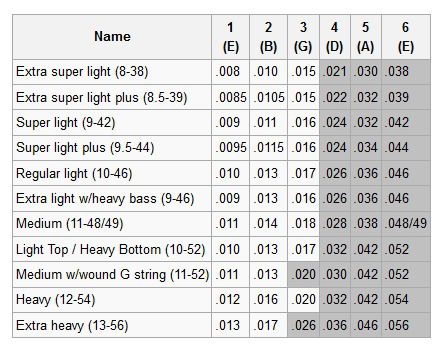Guitar Strings
There are many different genres of music out there, just as there is guitarist and guitar. Most guitarists will try there hardest to produce their own sound using amps and effects to suite there music, but it all begins with choosing the right strings.
Guitarist have a vast selection of strings to choose from and it's not just about choosing a good brand, you have to take string type and size into consideration, the slightest change in strings can have a huge effect on tone and play ability.
Round wounds

Round wounds are your most common string, they come as standard on most new guitars. They have a round or hexagonal core with a round wire wrapped round it tightly. Due to the way the wire is wrapped around the core of the string, you get tiny little bumps all along the string and it moves loosely around the core. These strings have a particularly bright tone, but due to the looseness of the wire, these strings create a bit of feedback, causing the string to squeak when you maneuver your fingers, also due to the grooves of the spiralling, dirt and air can get trapped, shortening the life of the strings. Also the little bumps because more friction to the player's fingers and the fret board causing quicker fret ware.
These strings are the easiest to manufacture and are the most affordable.
Flat wounds Flat wound strings are my personal favourite; they were designed mainly for blues and jazz. These strings have the same type of core as the round wounds, but instead of the wire being rounded, it has a square cross section, this allows the wire to wrap tighter with no bumps giving the strings a smooth surface. The lack of bumps provides more comfort for the player and easier maneuverability to the strings. The feedback and squeaking is decreased because of the smoothness of the string, this also provides a lower tone making them ideal for jazz music.
Flat wound strings are my personal favourite; they were designed mainly for blues and jazz. These strings have the same type of core as the round wounds, but instead of the wire being rounded, it has a square cross section, this allows the wire to wrap tighter with no bumps giving the strings a smooth surface. The lack of bumps provides more comfort for the player and easier maneuverability to the strings. The feedback and squeaking is decreased because of the smoothness of the string, this also provides a lower tone making them ideal for jazz music.
Half wound, ground wound, pressure wound

These strings are a cross between flat wounds and round wounds; they are manufactured a little differently. Same rules apply, wrapping a round wire round a round or hex core to make your round wound string, but they are then grinded until they are flat. This process allows a guitarist to have the comfort of flat wounds whilst maintaining some of the brightness from the round wound strings. This particular type of string is comfortable to play but is little harsher then flat wounds, making them perfect for rock, punk and heavier music.
Gauge
The term Gauge is used for when referring to a strings thickness; every guitarist will have a different preference.
Thinner strings provide a bright tone and are far easier on the fingers, however the lack of mass makes them more fragile and they are eligible to easier breakage. Thicker strings have a lower, heavier sound, far stronger than light strings but are harder maneuver.
Note: If you decide you want to change string size, make sure the guitar is set up properly. If you go from gauge 9's to gauge 12's, the weight of the strings could damage the guitar.
My personal favourite are Di Dario Flat wound 10's. They are comfortable to play, they have a nice low, heavy tone, they are easier to maintain and allot stronger. The music I like to play is on the heavier side of rock music and even though they say "jazz strings" on the box, I personally think they sound good for the style of music I play. Make sure you try a few different string types and gauges to find your own sound.
